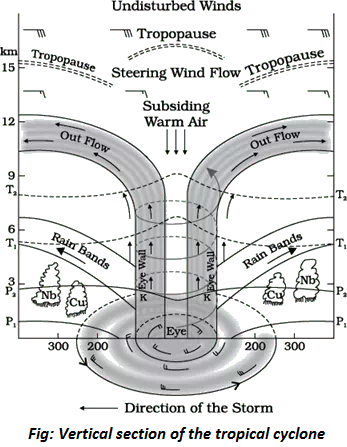-
14 Mar 2025
GS Paper 1
Geography
Day 4: What are cyclones? Differentiate between tropical and extratropical cyclones. (Answer in 125 words)
Approach
- Give a brief description about cyclone and its types.
- Highlight the differences between tropical and extra tropical cyclones.
- Illustrate through diagrams and give a concluding statement.
Introduction
Cyclones are rapid inward air circulation around a low-pressure area. The air circulates in an anticlockwise direction in the Northern hemisphere and clockwise in the Southern hemisphere. They are formed when warm, moist air over the ocean rises upward from near the surface. They are usually accompanied by violent storms and bad weather. They are classified into tropical and extratropical cyclones based on their origin and characteristics.
Body
Major differences between Tropical and Extratropical cyclones:
Basis Tropical Cyclone Extra-tropical Cyclone Characteristics A low-pressure center, a closed low-level atmospheric circulation, strong winds, and a spiral arrangement of thunderstorms that produce heavy rain. A large-scale low-pressure weather system that occurs in the middle latitudes of the Earth Formation It gets intensified over warm tropical oceans and requires temperature higher than 27° C, presence of the Coriolis force, small variations in the vertical wind speed, a pre-existing weak low- pressure area or low-level-cyclonic circulation and upper divergent above the sea level system. It gets intensified in any part of extratropical regions of the Earth (usually between 30° and 60° latitude from the equator), either through cyclogenesis or extratropical transition. Energy Source Warm ocean temperatures and latent heat release Temperature differences (cold and warm air masses) Movement It moves from east to west. It moves from west to east. Nature of Cyclone Violent storms Static, not violent Type Warm Core Cold Core Region Tropics of Capricorn and Cancer Temperate zones and high latitude regions Wind Velocity and destruction Much greater (100 – 250 kmph) (200 – 1200 kmph in upper troposphere)
Greater destruction due to winds, storm surges and torrential rains.
Comparatively low. Typical range: 30 – 150 kmph.
Less destruction due to winds but more destruction due to flooding.
Season It is seasonal. Occurs in late summers (Aug – Oct). It is Irregular as few occur in summers and more in winters. Rainfall Rainfall is heavy but does not last beyond a few hours. If the cyclone stays at place, the rainfall may continue for many days. Rainfall is slow and continues for many days, sometimes even weeks. Isobars Complete circles and the pressure gradient are steep Isobars are usually ‘V’ shaped, and the pressure gradient is low. Lifetime Doesn’t last for more than a week Usually lasts for 2-3 weeks. Calm region The center of a tropical cyclone is known as the eye. The wind is calm at the center with no rainfall. In a temperate cyclone, there is not a single place where winds and rains are inactive. Impact on India Both coasts are affected. But the east coast is the hot spot. Bring rains to North – West India. The associated instability is called ‘Western Disturbances’. Conclusion
Both tropical and temperate cyclones cause devastating impacts leading to loss of life and property. It causes local as well as global impacts affecting the weather system of the world. Therefore, it is crucial to study their causes, work on its mitigation and management in view of the growing blue economy of the world.





